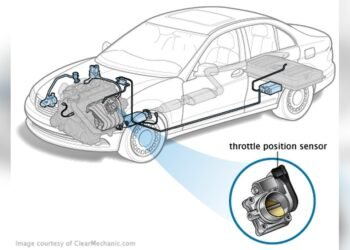Yes, semi trucks are equipped with airbags for the protection of the driver and passengers in the event of a collision. Semi trucks, also known as tractor-trailers or 18-wheelers, play a crucial role in transporting goods across long distances.
With their large size and heavy weight, safety features are of utmost importance. One such safety feature is the presence of airbags. These airbags are designed to deploy in the event of a collision, helping to reduce the risk of severe injuries or fatalities.
The airbags in semi trucks are typically located in the front, specifically for the driver and sometimes for the passenger as well. They work by inflating rapidly upon impact, providing a cushioned barrier between the occupants and the hard surfaces of the truck’s interior. In this way, airbags help to absorb some of the impact forces, reducing the likelihood of serious injuries.
Safety Features In Semi Trucks
Semi trucks are equipped with various safety features, including airbags, to protect drivers in case of accidents. These airbags help reduce the risk of severe injuries and provide an additional layer of safety on the road.
Ensuring safety in semi trucks is crucial for both drivers and other road users. These heavy vehicles are responsible for transporting goods across long distances, making it vital to prioritize safety features. Well-designed safety measures not only protect the lives of truck drivers but also help prevent accidents and reduce the severity of the injuries sustained in unfortunate events. In this blog post, we will explore the evolution of safety features in semi trucks, with a particular focus on the presence of airbags.
Evolution Of Safety Features In Semi Trucks
Over the years, the trucking industry has made significant advancements in improving safety for semi trucks. With the understanding that accidents can have devastating consequences, manufacturers have continuously innovated and incorporated enhanced safety features. The goal is to minimize the risk of collisions, mitigate the impact of accidents, and protect the lives of everyone involved on the road.
Let’s delve into some of the notable safety features that have evolved over time:
- Anti-lock Braking Systems (ABS): In the past, skidding and spinouts were common in heavy-duty vehicles. With the introduction of anti-lock braking systems, semi trucks gained the ability to maintain control and stability during sudden braking. ABS prevents wheel lockup, reduces the risk of rollovers, and ensures that drivers maintain steering control even on slippery roads.
- Electronic Stability Control (ESC): This technology revolutionized the safety aspect of semi trucks. By monitoring the vehicle’s movement and steering input, ESC can automatically apply brakes to specific wheels or reduce power to prevent loss of control. It enhances stability, particularly during sudden swerves or maneuvers at high speeds.
- Collision Mitigation Systems: These systems utilize radar, camera, and sensor technologies to detect potential collisions and provide visual and audible warnings to the driver. They can also apply emergency braking if the driver fails to respond in time. By acting as a second pair of eyes, these systems help prevent rear-end collisions and reduce the severity of accidents.
- Lane Departure Warning (LDW): LDW systems alert drivers when they unintentionally drift out of their lane. Vibrations or audible warnings notify the driver, allowing for immediate course correction. This technology helps prevent accidents caused by drowsiness, distraction, or other factors.
Do Semi Trucks Have Airbags?
Yes, semi trucks do have airbags! Contrary to popular belief, these vehicles are equipped with airbag systems for enhanced safety. However, it is important to note that airbags in semi trucks are not designed to deploy during minor collisions or accidents. Instead, they are programmed to activate in the event of a significant impact, such as a rollover or frontal collision.
Semi truck airbags are generally located in the cabin area, including the steering wheel and other strategic positions where they can protect the driver in the event of an accident. The deployment of airbags can help cushion the impact and minimize the potential for severe injuries.

Types Of Safety Features In Semi Trucks
Semi trucks are equipped with a range of safety features, including airbags. These airbags provide added protection for the drivers in the event of a collision, ensuring their safety on the road.
Semi trucks, also known as tractor-trailers or 18-wheelers, are essential for transporting goods across long distances. Due to their immense size and weight, ensuring the safety of both the drivers and other road users is of paramount importance. To achieve this, manufacturers have implemented various safety features in these vehicles. This article focuses on the different types of safety features found in semi trucks, including passive safety features, active safety features, and other safety measures.
Passive Safety Features
Passive safety features are designed to protect occupants in the event of a collision and minimize the risk of injuries. These features aim to increase the overall structural integrity of the semi truck and provide a secure environment for the driver and any passengers. Some common passive safety features found in semi trucks include:
- Seat Belts: Seat belts are vital safety components that secure the occupants in their seats, preventing them from being thrown forward in a collision. They help minimize the risk of serious injuries or ejection from the vehicle.
- Airbags: Semi trucks are equipped with airbags that deploy in the event of a crash. These airbags act as a cushion and provide additional protection to the driver and passengers, reducing the impact forces.
- Reinforced Cab Structure: The cab structure of a semi truck is reinforced to absorb and distribute crash forces. This reinforcement minimizes the deformation of the cabin, protecting the driver and occupants inside.
Active Safety Features
Active safety features are designed to prevent accidents and make driving a semi truck safer. These features utilize advanced technologies to assist the driver in maintaining control and avoiding potential hazards. Some common active safety features found in semi trucks include:
- Anti-lock Braking System (ABS): ABS prevents the wheels from locking up during hard braking, allowing the driver to maintain steering control. This technology enhances braking performance and reduces the risk of skidding.
- Electronic Stability Control (ESC): ESC helps prevent loss of control by automatically applying individual brakes and reducing engine power when it detects a potential skid or rollover.
- Blind Spot Detection: This feature uses sensors and cameras to detect vehicles in the truck’s blind spots. It provides visual or audible alerts to the driver, helping them make safer lane change decisions.
Other Safety Measures
In addition to passive and active safety features, there are other safety measures in place to enhance the overall safety of semi trucks. These measures include:
- Rear Underride Guards: Semi trucks are equipped with rear underride guards to prevent smaller vehicles from sliding underneath the rear of the truck in a rear-end collision.
- Visibility Enhancements: Manufacturers have incorporated features such as larger mirrors, rearview cameras, and improved lighting systems to enhance visibility and reduce blind spots.
- Driver Training and Education: Ensuring that drivers receive proper training and education on safe driving practices is essential. This includes teaching defensive driving techniques, understanding blind spots, and maintaining a safe distance from other vehicles.
In conclusion, semi trucks are equipped with a combination of passive and active safety features, as well as other safety measures, to protect the driver and other road users. These features and measures work together to minimize the risks associated with operating these large commercial vehicles, ensuring safer transportation on our roadways.
Advantages And Limitations Of Airbags In Semi Trucks
Semi trucks are the lifeblood of the transportation industry, carrying goods across the country and keeping our supply chains running smoothly. With their massive size and weight, safety is a top priority for these heavy-duty vehicles. One important safety feature found in some semi trucks is airbags. In this article, we will explore the advantages and limitations of airbags in semi trucks, examining how they can help protect drivers and passengers in the event of a collision, as well as their potential drawbacks.
Advantages Of Airbags In Semi Trucks
1. Improved Occupant Protection: Airbags in semi trucks provide an additional layer of protection for the driver and passengers during a collision. These safety devices can help reduce the risk of serious injuries, including head, chest, and other upper body trauma.
2. Mitigation of Impact Forces: Airbags work by inflating rapidly in the event of a crash, creating a cushioning effect that helps absorb and distribute the force of impact. This can help reduce the severity of injuries caused by the sudden deceleration that occurs during a collision.
3. Enhanced Safety in Rollover Accidents: Semi trucks are more prone to rollover accidents due to their high center of gravity. In such cases, airbags can provide crucial protection by preventing the occupants from being ejected or sustaining severe injuries as a result of the rollover.
It is important to note that airbags are designed to work in conjunction with seat belts rather than replace them. The combination of airbags and seat belts offers the best protection in the event of a collision.
Limitations Of Airbags In Semi Trucks
1. Limited Protection in Side and Rear Collisions: While airbags are effective in frontal collisions, their benefits in side and rear impact situations are limited. They offer little protection against the forces generated in these types of accidents, leaving occupants vulnerable to injuries.
2. Potential for False Deployments: Airbags are designed to deploy only in certain crash scenarios. However, they can occasionally deploy in non-crash situations, such as during a sudden braking maneuver or hitting a pothole. These false deployments can cause unintended injuries and require costly repairs.
3. Expensive Maintenance and Repairs: Airbag systems in semi trucks require regular inspection and maintenance to ensure their proper functioning. If an airbag deploys during a collision, it must be replaced, which can be a costly repair. Furthermore, the sensors and electronic components of the airbag system can be prone to failure, requiring additional expenses.
Despite these limitations, airbags in semi trucks can significantly improve overall safety by mitigating the impact of collisions and protecting occupants from severe injuries. It is essential for trucking companies and drivers to understand these advantages and limitations, ensuring that airbags are properly maintained and used in conjunction with other safety measures to maximize their effectiveness.
Improvements In Safety Technology For Semi Trucks
Safety technology in the automotive industry has come a long way in recent years, and the advancements are not just limited to passenger vehicles. Semi trucks, which play a vital role in transporting goods across the country, have also seen significant improvements in terms of safety features. One of the key areas of focus in enhancing the safety of semi trucks is the implementation of airbags. Let’s take a closer look at the emerging technologies for improved safety and the future outlook for safety in semi trucks.
Emerging Technologies For Improved Safety
In order to enhance the safety of semi trucks, manufacturers are actively exploring and implementing various emerging technologies. These innovative safety features are designed to minimize the risk of accidents and mitigate the severity of injuries in the event of a collision. Some of the notable technologies currently being integrated into semi trucks include:
- Collision Warning Systems: These systems utilize a combination of sensors, cameras, and radars to detect potential collisions and alert the driver. They can also automatically apply brakes or steer the vehicle to avoid an impending accident.
- Automatic Emergency Braking (AEB): AEB systems work in conjunction with collision warning systems to automatically apply the brakes when a potential collision is detected. This helps to reduce the impact force and prevent rear-end collisions.
- Blind Spot Detection: Semi trucks often have large blind spots, which increase the risk of accidents during lane changes. Blind spot detection systems use sensors to monitor the truck’s surroundings and alert the driver when there is a vehicle in the blind spot.
Future Outlook For Safety In Semi Trucks
The future of safety in semi trucks looks promising, with ongoing research and development focusing on further advancements in technology. Here are a few areas that hold great potential:
- Smart Adaptive Cruise Control: This technology goes beyond standard cruise control by incorporating sensors and cameras to maintain a safe distance from other vehicles. It automatically adjusts the speed and can bring the semi truck to a complete stop if necessary.
- Driver Monitoring Systems: These systems use advanced cameras and sensors to monitor the driver’s behavior and alert them if they show signs of fatigue, distraction, or impairment. This helps to ensure that drivers remain focused and alert while on the road.
- Connected Vehicle Technology: With the advent of the Internet of Things (IoT), semi trucks can now be connected to a network, enabling real-time communication with other vehicles and infrastructure. This connectivity allows for improved traffic management, collision avoidance, and overall safety.
Regulations And Industry Standards For Safety In Semi Trucks
Semi trucks, also known as tractor-trailers or 18-wheelers, play a crucial role in the transportation industry. With their immense size and weight, it is of utmost importance that these vehicles are equipped with safety features to protect both the driver and other road users.
Government Regulations For Safety In Semi Trucks
The government has put in place various regulations to ensure the safety of semi trucks on the road. These regulations cover a wide range of aspects, including the installation of airbags. Airbags, originally designed for passenger cars, have become increasingly common in semi trucks in recent years. The federal government, through the National Highway Traffic Safety Administration (NHTSA), has mandated the use of airbags in certain types of semi trucks.
The implementation of airbags in semi trucks is largely focused on protecting the truck driver in the event of a collision. These airbags are designed to deploy upon impact, providing a cushion for the driver and reducing the risk of severe injuries. Regulations stipulate the specific areas in the truck cabin where airbags should be installed, such as the steering wheel and the sides of the driver’s seat.
Industry Standards And Best Practices
In addition to government regulations, the trucking industry has developed its own set of standards and best practices to enhance safety in semi trucks. These standards are developed by various industry organizations such as the American Trucking Associations (ATA) and the Commercial Vehicle Safety Alliance (CVSA).
The industry standards cover a range of safety aspects beyond just airbags. They include requirements for regular maintenance and inspections of semi trucks to ensure that they are in optimal working condition. Moreover, they recommend the use of advanced safety technologies such as lane departure warning systems and collision mitigation systems.
These standards and best practices are not mandatory, but they serve as guidelines for trucking companies to follow. Oftentimes, trucking companies voluntarily adopt these standards to demonstrate their commitment to safety.
In conclusion, regulations and industry standards play a vital role in ensuring the safety of semi trucks. Government regulations mandate the use of airbags in certain types of semi trucks, while industry standards and best practices provide additional guidelines for trucking companies to enhance safety. By adhering to these regulations and standards, the trucking industry is taking steps to minimize accidents and protect the individuals who operate and share the road with these massive vehicles.
Frequently Asked Questions
Are Airbags Included In Semi Trucks?
Yes, most semi trucks are equipped with airbags to enhance the safety of drivers in the event of a collision.
How Do Semi Truck Airbags Work?
Semi truck airbags deploy rapidly upon impact, creating a cushioning effect that helps reduce the risk of severe injuries.
What Benefits Do Airbags Provide For Semi Trucks?
Semi truck airbags offer crucial protection for drivers by minimizing the force of impact during accidents, potentially preventing fatalities and severe injuries.
Is It Mandatory For All Semi Trucks To Have Airbags?
While airbags are not currently mandatory for all semi trucks, many manufacturers choose to include them as a standard safety feature.
Conclusion
The safety features of semi trucks are impressive, but when it comes to airbags, the situation is not as straightforward. While some newer models do offer airbag systems, it is not yet a universal standard in the industry. Implementing airbags in semi trucks presents various challenges, including the size and weight of the vehicles.
However, with ongoing advancements in technology and safety measures, it is likely that future models will continue to see improvements in this area. It is crucial for trucking companies and manufacturers to prioritize safety and explore every possible avenue to protect drivers in the event of a crash.
Learn More: How to Reset Airbag Light on Buick Enclave















